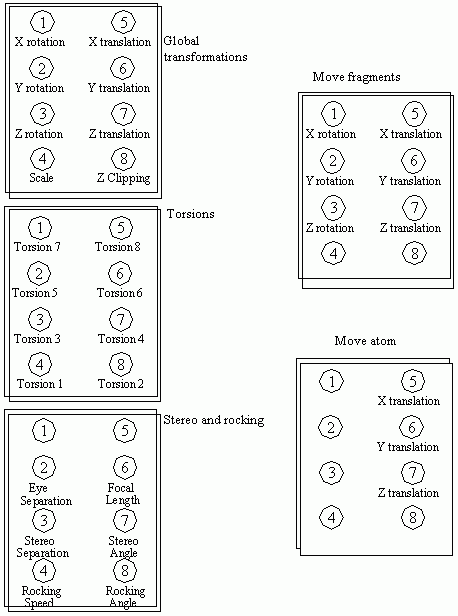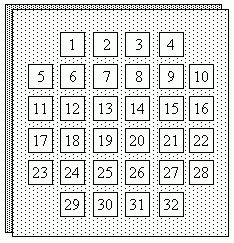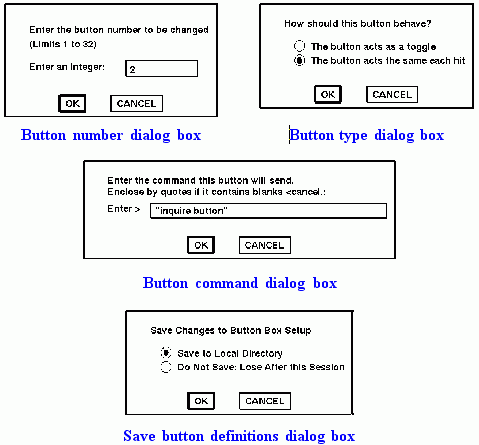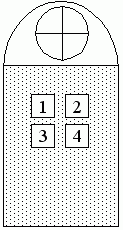
B. External Devices for Silicon Graphics Machines
This appendix describes various external hardware devices for SGI that can be used with QUANTA for issuing commands and moving structures. These devices duplicate operations that are performed using the dial emulators, mouse, and function keys that are integral to QUANTA.
Each device can be used to perform operations such as transformations, clipping, and scaling of a displayed structure. Using any of these devices, you also can execute commands that correspond to menu or palette selections.
Compatible external devices include:
Configuration information for these devices is included in the QUANTA Installation Guide.
Using a button box
A button box is used as an interface to specify palette selections and menu functions or issue QUANTA commands normally entered on the command line. The device is active only in the Molecular Modeling application. It has 32 function buttons that are numbered by row, from left to right.
Pressing a button sends a command to QUANTA. Depending on the command, a prompt may appear on the message line informing you of an appropriate action to take. The cursor must be in the modeling window in order for the buttons to work.
Default settings
By default, the buttons are assigned specific commands. However, these assignments can be overridden and the button box customized for your situation. Table 38 summarizes button functions.
Table 38. Button box default commands
|
Button
|
Function
|
Description
|
|
1
|
Set Stereo
|
Toggles the display between one and two images for stereo viewing.
|
|
2 - 3
|
Not Used
|
|
|
4
|
Reset View
|
Resets global transformations applied to molecular structures.
|
|
5
|
All Tools Off
|
Resets the display, clearing any display of distances, neighbors, and bumps. Selected palette tools are turned off.
|
|
6
|
Clear ID
|
Removes the display of atom IDs and distances from the molecular structure. This does not affect labels generated by the Label Atoms function.
|
|
7
|
Set Origin
|
Prompts for an atom pick and places that atom at screen center. The atom becomes the center of rotation for subsequent operations.
|
|
8
|
Center
|
Calculates the geometric center of picked atoms and places it at screen center. The geometric center becomes the center of rotation for subsequent operations.
|
|
9
|
Neighbors
|
Calculates and displays the nearest neighbors to subsequently picked atoms.
|
|
10
|
Geometry
|
Toggles off and on the palette tools that calculate the distance between pairs of picked atoms, the angle between successive triplets of picked atoms, and the dihedral angle between successive quadruplets of picked atoms. Results are displayed in the textport.
|
|
11
|
Move Fragment
|
Prompts for an atom pick to specify a molecular fragment to transform.
|
|
12
|
Move Set
|
Prompts for an atom pick to specify a set to transform independently.
|
|
13
|
Move Atom
|
Prompts for an atom pick to specify an atom to translate in the x, y, and z directions.
|
|
14
|
Torsions
|
Displays the torsions palette and prompts for an atom selection to define torsions for bond rotations.
|
|
15
|
Spin
|
Automatically creates new conformations by rotating about active torsions. Searches for close contacts and stops when it finds a conformation with no close contacts or after searching every conformation.
|
|
16
|
Cut Residue
|
Prompts for a residue selection and creates a molecular fragment by breaking all existing bonds between the selected residue and the molecular structure.
|
|
17
|
Continuous
|
Sets and unsets interactive updates for Bump, R/Ro, and Energy calculations. When set, results of the calculation are updated and displayed interactively. When not set, a calculation is performed only when requested.
|
|
18
|
Energy
|
Provides a quick relative energy calculation between static and dynamic parts of a molecular structure. The energy calculation is a 6-12 van der Waals potential and a Coulombic electrostatic potential between nonbonded atom pairs. One atom in the pair belongs to the static portion of the molecular structure; the other atom belongs to the dynamic portion of the molecular structure. Parameters used in this calculation are those assigned to atoms in the parameter file.
|
|
19
|
Bump
|
Calculates and displays close contacts between atoms. Close contacts are defined as distances between two atoms within a bump cut-off value.
|
|
20
|
R/Ro
|
Calculates the ratio of the current distance between atom pairs to the radius for an optimal van der Waals interaction. When this ratio is less than one, the atoms are too close, and a dashed line connects the atoms with the value of the ratio. When the ratio is equal to one, the atoms are at an optimal distance; when the ratio is greater than one, the atoms are beyond the optimal van der Waals separation.
|
|
21
|
Bond
|
Creates a temporary bond (for example, to simultaneously manipulate fragments).
|
|
22
|
Bond Break
|
Prompts for two atoms to be picked, then removes the bond between the two selected atoms.
|
|
23
|
Save
|
Updates the conformation of the molecular structure, incorporating any torsional, fragment, or atom transformations.
|
|
24
|
Reject
|
Removes all conformational changes since the MSF was last saved, and reconstructs the picture from the MSF saved to disk.
|
|
25
|
Zero
|
Removes all conformational changes since the structure was last saved, removing the most recent modeling transformations.
|
|
26 -28
|
Not Used
|
|
|
29
|
Global Dials
|
Activates Dial Set 1 to perform global transformations.
|
|
30
|
Fragment Dials
|
Activates Dial Set 2 (Fragment Motion).
|
|
31
|
Torsion Dials
|
Activates Dial Set 3 (Torsions).
|
|
32
|
Display Dials
|
Activates Dial Set B to modify the stereo focal length, eye separation, viewing angle and separation, as well as the rocking angle and speed.
|
Customizing the button box
Button box functions can be customized to meet specific requirements. Open the Preferences menu and select Device Settings to display a pull-right menu. Select Button Box from the pull-right menu and a series of dialog boxes is displayed. The first dialog box (1 in the figure below) asks you to specify which button to assign to a QUANTA command.
A button can act as a toggle or perform the same operation each time it is pressed. After the button number is specified, a dialog box is displayed (2 in the figure above) to specify the behavior of the button.
A third dialog box (3 in the figure) asks you to enter the command to send when the button is pressed. If the button is a toggle, another dialog box (4 in the figure) is displayed to enter the alternative command.
This process continues until Cancel is chosen from the Button Number dialog box. A correlation between buttons and QUANTA commands is established, and a dialog box requests whether or not to save the new button definitions to a file.
When the definitions are saved, the new button definitions override all default settings, and the file button.dat is created in your current directory. Subsequent QUANTA sessions initialize the button box according to this file. When the choice:
Do Not Save; Lose After this Session
is selected, new button definitions are not written to a file for use in subsequent sessions.
Using a dial box
A dial box is a set of eight dials that perform operations such as translation, rotation, scaling, and clipping. This device is used as an alternative to the dial emulators for global transformations, rocking and stereo variables, fragment movement, atom movement, and torsion transformations. The dials perform specific operations according to the current Dial Set selection. Table 39 summarizes Dial Set functions. The dial box figures summarize default dial assignments. The layout of the Global Transformations dial set can be customized using the Device Settings/Real Dials function on the Preferences menu.

Table 39. Dial box sets
|
Dial set
|
Function
|
|
1
|
Global transformations.
|
|
2
|
Move fragment.
|
|
3
|
Torsion rotations.
|
|
4
|
Move Atom. Dials 5, 6, and 7 translate an atom respectively in the x, y, and z directions.
|
|
B
|
Stereo and rocking variables. For use with a stereo viewing device. The separation of the two images and the angle of the image with respect to the viewpoint are controlled by dials 3 and 7. The speed and angle of the rocking function are controlled by dials 4 and 8. Eye separation and focal length are controlled by dials 2 and 6.
|
Using a graphics tablet
A graphics tablet can be used to select items from the QUANTA palette, menus, and display structure. It provides the same functionality as a mouse. This device consists of a four-button puck, a surface where the puck is placed, and a cursor. The cursor is drawn on the display screen and represents the puck's location on the tablet surface.
The responsive area of the tablet surface has a one-to-one correspondence to the display screen. The upper-left corner of the responsive tablet area maps directly to the upper-left corner of the display; the center of the tablet maps to the center of the display; and so on.
Three of the four puck buttons correspond to the three mouse buttons. The upper-left, upper-right, and lower-left puck buttons have the same functionality as the left, middle, and right mouse buttons, respectively. The lower right button on the puck is not used. The buttons are numbered by row from left to right
Button 1 is the selection button. Clicking this button while pointing to an object such as an atom, menu function, or palette tool sends the appropriate selection information to QUANTA for processing.
A graphics tablet can also control the orientation of molecular structures and viewing transformations. This is useful for quick manipulation of the image in the viewing area without having to select a new dial set from the
Dial Emulator window. Transformations performed with a graphics tablet are based on the speed and direction the puck moves on the tablet surface.
Global transformations
The graphics tablet performs global transformations of molecular structures in 3D space, duplicating the functionality provided by the first set of dial emulators. A molecular structure is manipulated by moving the puck on the tablet surface while simultaneously pressing a button or the <Shift> key. Table 40 summarizes actions you take to perform various transformations.
Table 40. Graphics tablet global transformations
|
Transformation
|
Key / button combination
|
|
X-Y Rotation
|
Press and hold button 2 while moving the puck. Rotation continues until the button is released.
|
|
Z Rotation
|
Press and hold button 3 while moving the puck. Rotation continues until the button is released.
|
|
X-Y Translation
|
Simultaneously press and hold button 2 and the <Shift> key while moving the puck. Translation continues until the button or the <Shift> key is released.
|
|
Z Translation
|
Simultaneously press and hold button 3 and the <Shift> key while moving the puck. Translation continues until the button or the <Shift> key is released.
|
|
Scaling
|
Press and hold the <Shift> key while moving the puck, without pressing a button. Scaling continues until the <Shift> key is released.
|
|
Z Clipping
|
Simultaneously press and hold button 1 and the <Shift> key while moving the puck. Z clipping continues until the button or the <Shift> key is released.
|
Fragment and atom movement
The graphics tablet can transform fragments and atoms in the viewing area, duplicating the functionality of Dial Emulator Sets 2 and 4. The transformation rate is determined by the speed and direction the puck moves across the tablet surface. The transformation type is determined by a keystroke/button combination. Table 41 summarizes actions to take for atom and fragment transformations.
Rotating torsions
Table 41. Graphics tablet atom/move fragment transformations
|
Transformation
|
Key / button combination
|
Fragment X-Y Rotation
|
Simultaneously press and hold button 2 and the <Ctrl> key while moving the puck. Rotation continues until the button or the <Ctrl> key is released.
|
Fragment Z Rotation
|
Simultaneously press and hold button 3 and the <Ctrl> key while moving the puck. Rotation continues until the button or the <Ctrl> key is released.
|
Fragment X-Y Translation
|
Press and hold the <Ctrl> key while moving the puck. Translation continues until the <Ctrl> key is released.
|
Fragment Z Translation
|
Simultaneously press and hold button 1 and the <Ctrl> key while moving the puck. Translation continues until the button or the <Ctrl> key is released.
|
Atom X-Y Translation
|
Simultaneously press and hold button 1, button 2, and the <Shift> key while moving the puck. Translation continues until a button or the <Shift> key is released.
|
Atom Z Translation
|
Simultaneously press and hold button 1, button 3, and the <Shift> key while moving the puck. Translation continues until a button or the <Shift> key is released.
|
The graphics tablet can also rotate torsions. The speed and direction of puck movement controls the torsional rotation. To rotate torsion angles, the <Alt> key is pressed and held in conjunction with none, one, or more buttons. While the <Alt> key is pressed, moving the cursor in the viewing area rotates a torsion angle.
The <Alt> key/button combination determines which torsion angle is rotated. These are listed in Table 42. Rotation continues until the <Alt> key is released.
Table 42. Graphics tablet torsion rotations
|
Torsion angle number
|
Key / button combination
|
Torsion Angle 1
|
<Alt> key only.*
|
Torsion Angle 2
|
<Alt> key and button 1.*
|
Torsion Angle 3
|
<Alt> key and button 2.
|
Torsion Angle 4
|
<Alt> key and button 3.
|
Torsion Angle 5
|
<Alt> key, button 1, and button 2.
|
Torsion Angle 6
|
<Alt> key, button 1, and button 3.
|
Torsion Angle 7
|
<Alt> key, button 2, and button 3.
|
Torsion Angle 8
|
<Alt> key, button 1, button 2, and button 3.
|
*Note: Use <Ctrl>-<Alt>-<Shift> for these operations if the <Alt> key actions invoke the window manager features on Linux.
|
Miscellaneous transformations
Several transformations are provided to support QUANTA applications and functions. You can perform these using the graphics tablet, moving the cursor in the viewing area while simultaneously pressing a button and, depending on the transformation, the <Shift> or <Ctrl> key. Table 43 summarizes the specific actions to take for each transformation.
Table 43. Graphics tablet miscellaneous transformations
|
Transformation
|
Key/button combination
|
Comparison Flash Speed
|
Simultaneously press and hold button 2 and button 3 while moving the puck. The speed increases/decreases until a button is released.
|
Dynamics Frame
|
Simultaneously press and hold the <Shift> key, button 2 and button 3 while moving the puck. The dynamics frame continues to change until a button or the <Shift> key is released.
|
Dynamics Speed
|
Simultaneously press and hold the <Shift> key, button 1, button 2, and button 3 while moving the puck. The dynamics speed continues to change until a button or the <Shift> key is released.
|
Stereo Angle
|
Simultaneously press and hold the <Ctrl> key, button 1, and button 2 while moving the puck. The angle of the structure with respect to the viewpoint increases/decreases until a button or the <Ctrl> key is released.
|
Stereo Separation
|
Simultaneously press and hold the <Ctrl> key, button 1, and button 3 while moving the puck. The angle of separation between the stereo images increases/decreases until a button or the <Ctrl> key is released.
|
Rock Speed
|
Simultaneously press and hold the <Ctrl> key, button 2, and button 3 while moving the puck. The speed of the rocking motion increases/decreases until a button or the <Ctrl> key is released.
|
Rock Angle
|
Simultaneously press and hold the <Ctrl> key, button 1, button 2, and button 3 while moving the puck. The angle of rotation of the rocking motion continues to change until a button or the <Ctrl> key is released.
|
User-defined transformations
The QUANTA Open Interface allows you to supply routines to define a dial set. User-defined dials can use the graphics tablet to adjust parameters specified in the definition. The input rate to these routines is determined by the speed and direction the puck moves across the tablet surface. The dial that this affects is determined by a keystroke/button combination. These are summarized in Table 44.
Table 44. Graphics tablet user-defined dial transformations
|
Transformation
|
Key/button combination
|
User-Defined 1
|
Simultaneously press the <Shift> and <Ctrl> key, while moving the puck. The transformation continues until one of the keys is released.
|
User-Defined 2
|
Simultaneously press the <Shift> key, <Ctrl> key, and button 1 while moving the puck. The transformation continues until one of the keys or the button is released.
|
User-Defined 3
|
Simultaneously press the <Shift> key, <Ctrl> key, and button 2 while moving the puck. The transformation continues until one of the keys or the button is released.
|
User-Defined 4
|
Simultaneously press the <Shift> key, <Ctrl> key, and button 3 while moving the puck. The transformation continues until one of the keys or the button is released.
|
User-Defined 5
|
Simultaneously press the <Shift> key, <Ctrl> key, button 1, and button 2 while moving the puck. The transformation continues until one of the keys or buttons is released.
|
User-Defined 6
|
Simultaneously press the <Shift> key, <Ctrl> key, button 1, and button 3 while moving the puck. The transformation continues until one of the keys or buttons is released.
|
Using a spaceball
A spaceball for SGI machines is an interactive device with six degrees of freedom. It is used to transform molecular structures in the viewing area. Transformations applied to a molecular structure correspond to the forces exerted on the ball. For example, lifting the ball translates a structure in the positive y direction; pressing down on the ball translates the structure in the negative y direction; pushing the ball left moves the structure to the left. When the ball is twisted, the structure rotates in the direction of the twist.
The spaceball has eight panel buttons programmed to control transformations, and a soft button located on the back of the ball. The buttons specify the type of transformations that are performed, reset the spaceball hardware, and initialize the orientation of the molecular structure. Button assignments are summarized in Table 45.
Table 45 . Spaceball button assignments
|
Button/function
|
Description
|
1/Translations
|
Controls the translations in effect by cycling through three states: translations on, translations off, translations only about the axis with the greatest force exerted.
|
2/Rotations
|
Controls rotations by cycling through three states: rotations on, rotations off, rotations only about the axis with the greatest force exerted.
|
3/Global Motion
|
Sets the spaceball to perform global transformations.
|
4/Global Scaling
|
Sets the spaceball to perform global scaling. Only the z direction affects scaling (that is, pushing the ball forward reduces the scale factor; pulling the ball back increases the scale factor).
|
5/Move Fragment
|
Sets the spaceball to transform the current fragment selection.
|
6/Move Atom
|
Sets the spaceball to translate the atom selected by the Move Atom tool. Rotations are ignored.
|
7/Not Used
|
|
8/Initialize
|
Resets the spaceball to prevent drift introduced by the hardware.
|
Soft/Reset
|
Resets the orientation of the molecular structure.
|

© 2006 Accelrys Software Inc.






